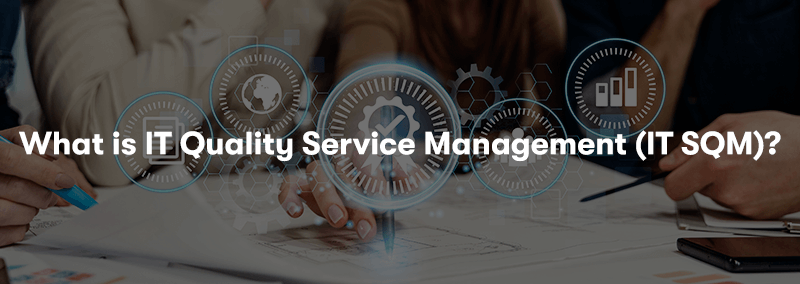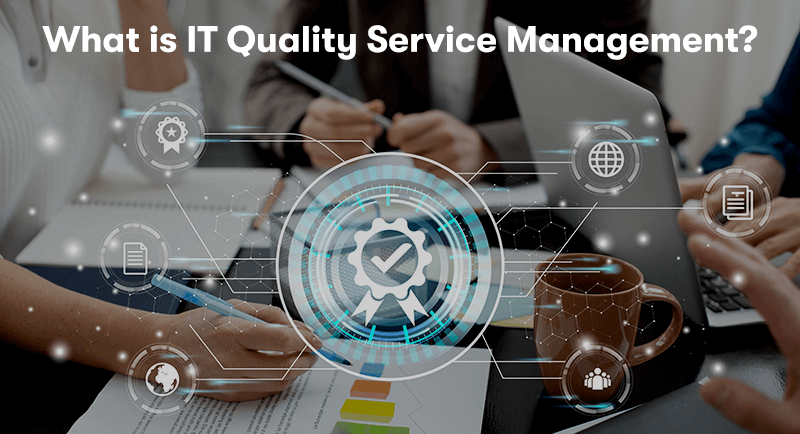What is IT Quality Service Management (IT SQM)?
The significance of delivering high-quality IT services cannot be overstated. Enter IT Service Quality Management (IT SQM), a strategic approach designed to elevate the standard of IT service delivery to new heights. At its core, IT SQM integrates comprehensive methodologies, frameworks, and practices to ensure IT services meet and exceed the expectations of businesses and their customers.
This discipline is pivotal in aligning IT services with business objectives, optimising operational efficiency, and fostering customer satisfaction. As organisations grapple with the challenges of digital transformation, IT SQM emerges as a beacon of excellence, guiding businesses towards achieving superior service quality and, ultimately, a competitive advantage in the digital arena.
What is IT Quality Service Management (IT SQM)?

IT Service Quality Management refers to the comprehensive approach and structured process for managing the quality of IT services. It focuses on ensuring that IT services meet the current and future needs of the business in alignment with agreed-upon service levels and customer expectations. The concept encompasses various frameworks, standards, and practices designed to enhance the effectiveness, efficiency, and satisfaction in the delivery of IT services. Here's a breakdown of its key components and objectives:
Quality Assurance and Control
IT SQM includes processes for ensuring that IT services are delivered at a consistent quality level. This involves quality planning, quality control, quality assurance, and quality improvement practices.
Customer Focus
The approach is deeply rooted in understanding and meeting the needs and expectations of customers (both internal and external to the organisation). It prioritises customer satisfaction through effective service delivery and support.
Continuous Improvement
IT SQM adopts a continuous improvement mindset, often utilising methodologies such as PDCA (Plan-Do-Check-Act) and quality frameworks like Six Sigma and Lean to enhance service delivery processes.
Standards and Frameworks
It often leverages established IT service management (ITSM) frameworks and standards such as ITIL (Information Technology Infrastructure Library), ISO/IEC 20000 (an international IT service management standard), and COBIT (Control Objectives for Information and Related Technologies) to guide the management of IT service quality.
Measurement and Metrics
Critical to IT SQM is the development and use of key performance indicators (KPIs) and other metrics to measure the quality of IT services. This data drives decision-making and improvements and demonstrates accountability and value to the business.
Integration with ITSM
While ITSM focuses broadly on the delivery and management of IT services, IT SQM zeroes in on the quality aspect within this domain, ensuring that services meet technical and business requirements and are delivered in a manner that maximises value, efficiency, and customer satisfaction.
By adopting IT SQM practices, organisations aim to enhance their IT service delivery capabilities, align IT services more closely with business goals, improve customer satisfaction, and ultimately support the overall performance and competitiveness of the business.
Why is IT SQM Important for Businesses?

IT Service Quality Management is crucial for businesses for several reasons, as it directly impacts an organisation's efficiency, reliability, and competitiveness in today's digital landscape. Here are key reasons why IT SQM is important for businesses:
Alignment with Business Objectives
IT SQM ensures that IT services are closely aligned with the business's strategic goals. This alignment ensures that IT initiatives support business growth, efficiency, and agility, making the organisation more responsive to market changes and opportunities.
Improved Customer Satisfaction
By focusing on the quality of IT services, businesses can significantly enhance the experience of their customers. High-quality IT services ensure that customer-facing systems are reliable, user-friendly, and responsive to customer needs, leading to higher satisfaction levels.
Enhanced Efficiency and Productivity
IT SQM practices lead to more streamlined and efficient IT processes. By adopting best practices and continuous improvement methodologies, businesses can reduce waste, optimise resource use, and improve the productivity of their IT teams and the broader organisation.
Risk Management
Quality management practices help identify, assess, and mitigate risks associated with IT services. This includes everything from cybersecurity risks to compliance and operational risks, ensuring that IT services are secure and resilient against disruptions.
Cost Savings
By improving the efficiency of IT service delivery and reducing downtimes and defects, IT SQM can lead to significant cost savings. Optimised processes and preventive measures against service failures reduce the need for corrective actions, which can be costly and resource-intensive.
Competitive Advantage
In an era where technology is a key driver of competitive advantage, the quality of IT services can set a business apart. Organisations consistently delivering high-quality IT services are better positioned to innovate, meet customer expectations, and capture market share.
Regulatory Compliance and Standards Adherence
IT SQM helps organisations adhere to industry standards and regulatory requirements related to IT service delivery and data management. This adherence is crucial for maintaining trust, avoiding legal penalties, and ensuring the integrity and security of data.
Scalability and Future-readiness
Quality management in IT services ensures the IT infrastructure is scalable, adaptable, and prepared for future technological advancements. This readiness supports business growth and evolution, enabling organisations to capitalise on new opportunities quickly.
Overall, IT SQM plays a pivotal role in ensuring that IT services contribute positively to an organisation's operational efficiency, customer satisfaction, and strategic goals. In the digital age, where technology underpins almost every aspect of business, investing in IT SQM is not just important—it's essential for survival and success.
What are the Main Principles of Quality Service Management in IT?

The main principles of Quality Service Management in IT are foundational guidelines that underpin the effective delivery and management of IT services to meet or exceed customer expectations. These principles are influenced by broader quality management and IT service management (ITSM) frameworks, such as ITIL, ISO/IEC 20000, and Six Sigma. Here are the key principles that organisations typically follow to ensure high-quality IT services:
Customer Focus
The primary goal of IT services is to fulfil customer needs and provide value to the business and its clients. Understanding and managing customer expectations are crucial to improving customer satisfaction and loyalty.
Leadership
Strong leadership is essential to establish a clear vision of quality objectives and to create an environment where everyone is engaged in achieving those objectives. Leadership ensures that the organisation is structured to facilitate the effective management and delivery of quality IT services.
Engagement of People
The competencies, empowerment, and engagement of people at all levels of the organisation are essential. Employees should be encouraged to contribute to service quality, improvement processes, and innovation.
Process Approach
Viewing service management as a set of interrelated processes helps in understanding how to achieve more efficient results. This approach emphasises the importance of managing activities and resources as processes that operate together to produce quality outcomes.
Improvement
Continual improvement of the organisation's overall performance should be a permanent objective. This involves regular review and improvement of processes, services, and the management system to address technological changes, business objectives, and customer needs.
Evidence-based Decision Making
Decisions regarding the management and improvement of IT services should be based on the analysis and evaluation of data and information. This principle ensures that actions are grounded in facts rather than assumptions.
Relationship Management
An organisation and its external providers are interdependent, and a mutually beneficial relationship enhances the ability of both to create value. Managing relationships with partners and suppliers is crucial to ensure that the services provided meet the required quality and standards.
Holistic Approach to Service Management
Recognising that IT service management involves various components such as processes, people, products, and partners. A holistic approach ensures that all elements are aligned and contribute effectively to service quality.
Transparency and Communication
Open communication and transparency in reporting and handling issues are vital for trust and effective service management. This includes clearly communicating roles, responsibilities, and expectations to all stakeholders.
By adhering to these principles, organisations can ensure that their IT service management practices not only support the delivery of high-quality services but also contribute to achieving business objectives and enhancing customer satisfaction. These principles serve as a foundation for adopting and adapting ITSM best practices and frameworks within an organisation.
Final Notes on IT Quality Service Management (IT SQM)?
In conclusion, IT Service Quality Management is an indispensable approach for businesses aiming to align IT services with strategic objectives, enhance customer satisfaction, and achieve operational excellence. Embracing the core principles of IT SQM—customer focus, leadership, engagement of people, process approach, continuous improvement, evidence-based decision-making, relationship management, and a holistic view of service management—organisations can unlock significant benefits.
These include improved efficiency, reduced risks, cost savings, and a competitive edge in the digital marketplace. As technology continues to evolve, investing in IT SQM practices is not merely an option but a critical necessity for businesses seeking to thrive in the dynamic and challenging landscape of the 21st century.


